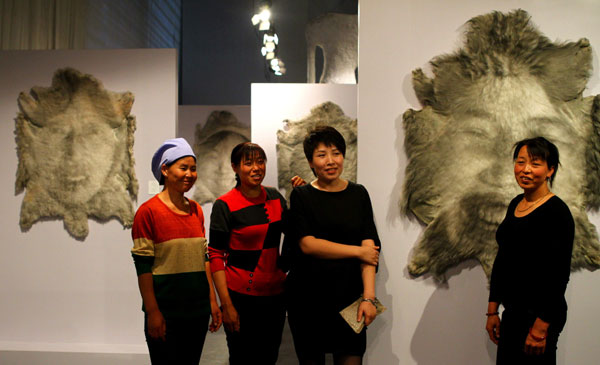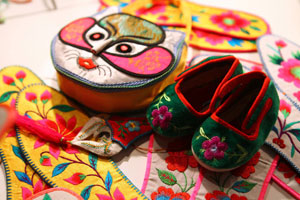Threads of change
Updated: 2012-10-11 07:41
By Chen Nan (China Daily)
|
|||||||||||
Wen Fang partners with underprivileged women to transform their traditional needlework into contemporary artwork. Chen Nan reports.
Artist Wen Fang gave the spotlight at the opening of her latest exhibition in Beijing, Thread Revolution, to eight women from the impoverished and arid Tongxin county in the Ningxia Hui autonomous region.
The women from Hequ village, who are 30-60 years old, worked with Fan to create the exhibition.
 |
|
Wen Fang (center) and women from Tongxin county in the Ningxia Hui autonomous region at the opening of her latest exhibition Thread Revolution in Beijing. Photo by Zou Hong / China Daily |
"They're the real artists behind this exhibition," Wen says.
Wen has remained committed to her project to alleviate poverty in the settlement in southern Ningxia through art creation since 2009. She met the women through the Hundred Flowers Women's Cooperative to which they belong, which worked with the French NGO Femmes du Ningxia (Women of Ningxia) Wen cooperated with.
"The title suggests a revolution fought with thread, which is the most traditional and ordinary thing in their lives," explains the 36-year-old Beijing native, who graduated from Louis-Lumiere in Paris and studied photography and sound engineering.
Wen and the women staged the art exhibitions Textile Dreams in 2010 and Heaven in 2011.
Rather than bringing the villagers' traditional embroidered items - clothes, wallets and quilts - to cities, Wen and the women used traditional materials to create innovative artworks.
Wen says this exhibition's pieces feature more creative input from the women than the previous shows.
"This time, they are not simply executing my ideas but, rather, are using their own imaginations," Wen says.
"Although these women have never received formal art education, they have their own aesthetics, which have been nurtured by the unique place they've grown up."
Ding Ting, one of the women from Ningxia, stared at an artwork composed of dozens of pairs of insoles hand-embroidered with different color patterns.
"It's our latest artwork," Ding says smiling.
Poverty forced her to drop out of school and marry at age 17. She doesn't have a job, and her household depends on the money her husband earns as a migrant worker in a nearby town.
The 34-year-old never imagined that something as ordinary as embroidering would have an extraordinary impact on her life - until Wen showed up.
"She told us she was an artist, but we didn't know what art is," Ding says, laughing.
"We figured she was just a traveler, who would stay in our village for a few days. We never imagined she would stick with us for three years and change our lives."
|
 |
| Hand-embroidered pieces by rural women from Tongxin county of Ningxia. Photos by Zou Hong / China Daily |
"The money I've made through this project is enough to pay for my child's education," Ding says.
The exhibition runs until Oct 23.
Gehua Design Center's managing director Huang Hung recalls she first encountered Wen's work in a small gallery in Beijing's 798 art district five years ago. Wen had printed the faces of smiling construction workers on bricks.
"Wen creates portraits of orphans and installations about the homeless," Hung says.
"Her work is clearly removed from the money-driven contemporary art bubble."
Wen's underprivileged upbringing inspired her to focus on society's marginalized people in her early works, she says.
Her 2009 work To Keep on Living shows photos of poor children printed on small wooden desks. It sold for more than 200,000 yuan.
"My art brought me attention and wealth," Wen says.
"But what about the children whose photographs are in that art? I want them to benefit, too."
When Wen started working with the women in Ningxia, she believed she was helping them alleviate poverty. But she found these women helped her.
"I grew up in Beijing and naturally think people who have less money or fewer material things are poorer than me," she says.
"But after I stayed with these women, I learned that they're rich in skill. They helped me realize artistic ideas I couldn't achieve without them."
Wen says that some fashion brands have contacted her to design and make products with the women. She's still considering the best way to approach the offers.
"The project will continue but it won't be called 'poverty alleviation through art'," she says.
"We work together. We contribute equally. And we'll move forward together."
Contact the writer at chennan@chinadaily.com.cn.
Related Stories
Unique Xinjiang embroidery 2012-07-24 14:21
Populous diverdifolia embroidery made in Mori, China's Xinjiang 2012-07-24 14:11
Introduction to Yao Jianping’s embroidery art 2012-07-04 16:37
Suzhou embroidery 2012-07-04 11:15
Traditional embroidery endangered 2012-06-13 08:51
A queen of embroidery creates a royal portrait 2012-06-04 15:39
Today's Top News
President Xi confident in recovery from quake
H7N9 update: 104 cases, 21 deaths
Telecom workers restore links
Coal mine blast kills 18 in Jilin
Intl scholarship puts China on the map
More bird flu patients discharged
Gold loses sheen, but still a safe bet
US 'turns blind eye to human rights'
Hot Topics
Lunar probe , China growth forecasts, Emission rules get tougher, China seen through 'colored lens', International board,
Editor's Picks

|

|

|

|

|

|





